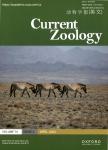Color change in a marine isopod is adaptive in reducing predation
在海洋动物的颜色变化的自适应减少捕食作者机构:Department of Biology Seattle University 901 12^th ave. Seattle WA 98122
出 版 物:《Current Zoology》 (动物学报(英文版))
年 卷 期:2015年第61卷第4期
页 面:739-748页
核心收录:
学科分类:0710[理学-生物学] 07[理学] 08[工学] 0822[工学-轻工技术与工程] 0713[理学-生态学]
基 金:funded by a grant from the M.J. Murdock Charitable Trust administered through Seattle University
主 题:Isopod Pentidotea wosnesenskii. Camouflage Crypsis Background matching Color change
摘 要:Although background matching is a common form of camouflage across a wide diversity of animals, there has been surprisingly little experimental work testing the fitness consequences of this camouflage strategy, especially in marine ecosystems. In this study, we tested whether color camouflage enhances survival of the intertidal marine isopod Pentidotea (Idotea) wosnesenskii, quantified patterns of camouflage in different algal habitats, and examined how algal diet affected color change and growth using laboratory assays. In the field, isopods collected from two differently colored algal habitats (the brown alga Fucus distichus and the red alga Odonthaliafloccosa) matched the color of their respective algal habitats, and also differed significantly in body size: smaller red isopods were found on red algae, while larger brown isopods were found on brown algae. Predation ex- periments demonstrated these color differences had fitness benefits: brown isopods that matched their brown algae habitats sur- vived at higher rates than red unmatched isopods. Surprisingly, despite the propensity of isopods to match their algal habitats, algal diet had no effect on color change in color change experiments. Instead, isopods in all treatments turned browner, matching the color of the algal habitat that many isopods are found on as adults. In summary, our data supported our hypothesis that back- ground matching serves an adaptive function in reducing predation, with important evolutionary implications for explaining the wide variation in color change mechanisms in idoteid isopods [Current Zoology 61 (4): 739-748, 2015].



